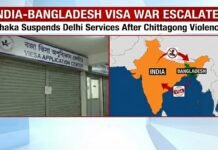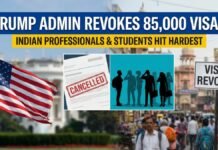
Key Points:
- Government shutdown began October 1, 2025 now the longest in US history at 35+ days
- Nearly 13,000 air traffic controllers working without pay since mid-October
- Sunday, November 2 saw nearly 6,000 flight delays and 244 cancellations; Friday saw 6,200+ delays
- TSA security lines at major airports exceeding 3-4 hours; some cities experiencing 4+ hour waits
- 80% of air traffic controllers absent in some New York facilities on peak days
- 730,000 federal workers working without pay; 670,000 furloughed entirely
- Republicans and Democrats blame each other over healthcare and spending demands
- Shutdown will surpass 2018-19 record when it reaches Day 35 on November 4
- First hints of possible compromise emerging between Senate Republicans and Democrats
Washington: The US aviation system faces its most severe disruption in decades as the government shutdown enters its sixth week with no resolution in sight. The crisis centers on approximately 13,000 air traffic controllers classified as “essential workers” who must continue performing their safety-critical duties despite missing multiple paychecks. Controllers and TSA security personnel have become the human casualties of partisan gridlock, working extended shifts under mounting financial stress.
Record-Breaking Flight Delays and Cancellations
The impact on travelers has been dramatic and escalating. On Friday, October 31, the FAA reported 6,200 delayed flights and 500 cancellations across the United States. This intensified into the weekend when Sunday, November 2, produced nearly 6,000 delays and 244 cancellations. By early Monday morning, hundreds more flights were already delayed before noon, establishing a pattern of sustained disruption rather than isolated incidents.
Major airports bore the brunt of the chaos. Newark Liberty International Airport reported ground delays exceeding four hours on a single day. Staffing trigger alerts—an FAA system indicating critically low controller staffing—were activated simultaneously at airports in Nashville, Jacksonville, Austin, and Denver, suggesting the problem extended beyond isolated facilities to become systemic nationwide.
Transportation Secretary Sean Duffy acknowledged the deteriorating conditions on CBS News, warning that “airport delays are going to get worse” before any resolution emerges. He emphasized that mandatory overtime and reduced traffic volume have become the only tools preventing aviation catastrophe, stating: “We work extra hours to guarantee the system’s safety. Consequently, we will slow down traffic, resulting in delays and cancellations to maintain safety.”
Air Traffic Controllers’ Financial Crisis
Air traffic controllers have endured particular hardship, missing their first full paychecks in late October after the shutdown began on October 1. Many controllers have been working mandatory six-day weeks with 60+ hour schedules even before the shutdown, according to Fortune, and the added burden of working without compensation has driven them to desperate measures.
Nick Daniels, president of the National Air Traffic Controllers Association (NATCA), told Fortune reporters that controllers now work their day jobs controlling critical air traffic, then pivot to secondary employment as restaurant servers and Uber drivers to provide for their families. This dual-employment reality creates obvious safety concerns—controllers operating on reduced sleep while juggling financial desperation.
Some controllers have engaged in “sick-outs,” refusing to work until compensation resumed. These informal strikes, while technically unauthorized, have contributed significantly to flight disruptions. For instance, on Friday, nearly 80% of air traffic controllers in New York facilities were reportedly absent, leading Transportation Secretary Duffy to blame controller absences for 65% of that day’s flight delays.
Secretary Duffy stated that while controllers resort to second jobs out of financial necessity, the administration will not terminate controllers for exercising this choice: “When they are making choices to support their families, I will not dismiss air traffic controllers.” However, the FAA was already short approximately 3,500 controllers before the shutdown began—a structural shortage that the shutdown has exacerbated beyond capacity.
Security Checkpoint Chaos
Beyond flight operations, Transportation Security Administration (TSA) personnel—also working without pay—have caused security lines to balloon to unprecedented lengths. Major airports in Houston, San Diego, and other major cities reported wait times exceeding three hours during peak hours. These delays compound the aviation crisis by creating gridlock before passengers even reach their gates.
Houston Bush Intercontinental Airport experienced security waits surpassing three hours, forcing travelers to arrive hours earlier than normal or risk missing flights. The situation reflects TSA staffing shortages as employees call in sick due to financial hardship, though not to the same degree as air traffic controllers.
Systemic Shutdown Casualties
The aviation crisis represents only one dimension of a broader federal government collapse. The Bipartisan Policy Center estimates 730,000 federal workers are currently working without pay, while 670,000 more have been furloughed entirely without even the dubious privilege of continued employment. The shutdown has already eliminated November SNAP (food assistance) benefits, which prompted multiple federal judges to order restoration of the benefits despite the shutdown, according to Wikipedia’s compilation.
Political Stalemate and Blame Game
Republicans and Democrats remain deadlocked over funding priorities. Republicans have accused Democrats of demanding healthcare benefits for illegal immigrants—a charge Democrats strenuously deny. Democratic leaders counter that they merely seek to reverse Republican cuts to existing healthcare benefits for American citizens. Neither side has demonstrated willingness to compromise significantly.
President Trump has repeatedly demanded that Senate Republicans eliminate the filibuster rule (which requires 60 votes for most legislation), allowing him to pass Republican-preferred funding bills with only Republican votes. Senate Majority Leader John Thune has consistently rebuffed this demand, stating his position differs from the President’s.
However, a potential breakthrough emerged on November 3. Reuters reported “first glimmers toward ending” the shutdown, with both Senate Republican and Democratic leaders discussing possible “off-ramps” to the crisis. Senate Majority Leader Thune expressed cautious optimism while warning senators not to “push it,” suggesting fragile negotiations may be occurring behind closed doors.
Historical Significance
The shutdown’s significance extends beyond immediate disruption. If it continues through November 4, it will officially surpass the 2018-19 shutdown that lasted 35 days during President Trump’s first term, becoming the longest in American history. This second-longest status already represents a policy failure of substantial magnitude.
The 2025 shutdown represents the 21st funding gap and 11th government shutdown in modern US history, and the third during a Trump presidency. Each previous protracted shutdown has concluded with compromises neither side initially favored—suggesting that eventual resolution will likely require reciprocal concessions from both parties.
Aviation Safety Concerns
Despite Transportation Secretary Duffy’s repeated assurances that no safety compromises have occurred, the combination of understaffed air traffic control facilities operating on overtime, controllers working secondary jobs while unpaid, and mounting fatigue represents a potential disaster waiting to happen. Duffy did state he would “shutter US airspace” if safety became compromised, but the fact that he’s making such statements suggests how close the system has operated to critical thresholds.
Airlines’ Escalating Demands
United Airlines CEO Scott Kirby told reporters, “It’s putting stress on people. It’s not fair to those people. It’s also putting stress on the economy.” Airlines have formally called on Congress to resolve the shutdown, emphasizing that the aviation industry faces operational constraints similar to those that previously contributed to ending government shutdowns when public pressure became sufficiently severe.
What Comes Next
As the shutdown approaches historic records, both parties face mounting pressure from federal employees, traveling public, and economic data suggesting the prolonged shutdown is inflicting measurable damage on GDP growth. The aviation industry’s visibility as a daily disruptive force affecting millions of Americans may finally push negotiators toward compromise after more than a month of intransigence.
However, without concrete movement by November 4-5, the shutdown will set a new record, potentially emboldening whichever party is blamed in public polling to hold firm in the belief that the other side will eventually capitulate first. The next 48 hours may prove decisive in determining whether the crisis resolves this week or extends into mid-November.



















































